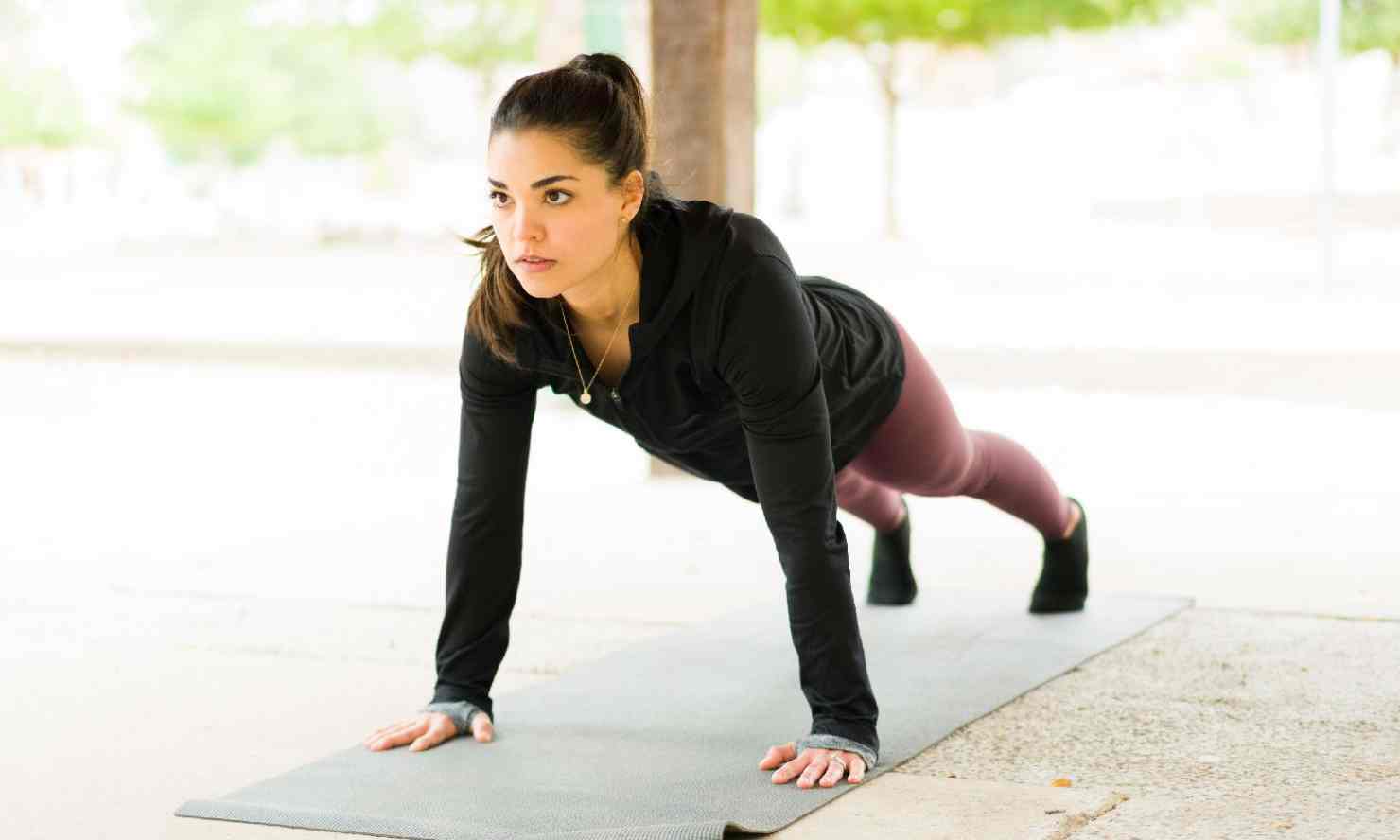
By now, everyone knows there are numerous benefits of exercise, and one of those benefits includes the potential to extend life. This is even true for people who are already in their 60s and 70s.
In fact, recent research published in the journal JAMA Network Open found that women 65 and older who met the recommended guidelines of at least 2.5 hours of aerobic exercise and at least two days of strength training per week had a lower risk of all-cause mortality than those who did not.
“We found that each type of physical activity was independently associated with a lower risk of all-cause mortality in older adults,” study author Dr. Bryant Webber, an epidemiologist in the Division of Nutrition, Physical Activity, and Obesity at the U.S. Centers for Disease Control and Prevention, shared with CNN.
“Those who met the muscle-strengthening guideline only (versus neither guideline) had (a) 10% lower risk of mortality, those who met the aerobic guideline only had 24% lower risk of mortality, and those who met both guidelines had 30% lower risk,” he said.
What is the one specific exercise that helps you live longer? According to research published in the Journal of the American College of Cardiology and Progress in Cardiovascular Diseases, running may extend your life up to three years. (The new sport of pickleball also boasts some longevity benefits.)Ad
Running: Exercise that Helps You Live Longer
That’s right — running is a life extender, even if you run as little as five minutes per day. Even more remarkable, subjects in the study who ran lived about three years longer than non-runners, even if they were overweight, drank, smoked, or run slowly or sporadically.
How can this be so? Good question.
What, exactly, did the researchers find in reviewing this study? According to Dr. Duck-chul Lee, a professor of kinesiology at Iowa State University, and his study co-authors, running dropped the risk for premature death by nearly 40 percent — even when controlling for a history of health issues like obesity or hypertension, smoking and drinking.
Extrapolating that data, the researchers concluded that if the non-runners in the study began running, there’d be 16 percent fewer deaths and 25 percent fewer fatal heart attacks.
You might be wondering, in order to make running an exercise that helps you live longer, how many miles a week should I run? That’s the fascinating part:
Perhaps most interesting, the researchers calculated that, hour for hour, running statistically returns more time to people’s lives than it consumes. Figuring two hours per week of training, since that was the average reported by runners in the Cooper Institute study, the researchers estimated that a typical runner would spend less than six months actually running over the course of almost 40 years, but could expect an increase in life expectancy of 3.2 years, for a net gain of about 2.8 years.
As little as five minutes a day has benefits on longevity, with the life-extending powers plateauing at about four hours of running per week. However, running more than four hours a week did not show any adverse effects, just a plateau, meaning there is no harm in running long so long as you give yourself enough recovery time and rest between workouts.
The reasons behind these findings are still unclear, and this does not mean that running necessarily causes longevity to increase. It’s more likely, according to Lee, that because running combats so many health issues — such as high blood pressure and excess weight — it helps overall health, which in turn boosts longevity.
In fact, running isn’t the only exercise that helps you live longer. Walking, cycling and other exercise have also been shown to drop mortality risk by about 12 percent. It’s just that running seems to be the most effective exercise that helps you live longer.
Running and Telomeres
Beyond just combating high blood pressure, obesity, coronary heart disease and more, running seems to lengthen telomeres, segments of DNA at the end of our chromosomes that control aging.
One of the largest studies to date on telomeres shed some light on telomeres’ effect on a person’s health. Researchers collected saliva samples and medical records of more than 100,000 participants. Their findings showed that shorter-than-average telomere length was associated with a boost in mortality risk — even after adjusting for lifestyle factors like smoking, alcohol consumption and education that are linked to telomere length.
The study found that individuals with the shortest telomeres, or about 10 percent of the study’s participants, were 23 percent more likely to die within three years than those with longer telomeres. While science still isn’t 100 percent sure how telomere length affects how we age, it’s clear that the longer our telomeres are, the better. As luck would have it, it turns out running helps extend telomeres.
Research published in the New York Times about how exercise keeps your cells young found that middle-aged adults who were intense runners (45–50 miles a week) had telomere lengths that were, on average, 75 percent longer than their sedentary counterparts.
Running Tips
While running is clearly an exercise that helps you live longer, you also don’t want to live in pain. That means you need to learn how to run properly and light on your feet.
According to research published in the British Journal of Sports Medicine and tips from Harvard researchers, take the following directions to heart while running:Ad
- Experiment with landing closer to the midfoot if you’re a heel striker. Most runners naturally land more lightly when they don’t lead with the heel.
- Slightly increase cadence — the number of steps you take per minute. This seems to reduce pounding from each stride.
- Imagine you’re running on eggshells or attempting to “run on water,” so to speak, trying to remain light on your feet.
- Don’t overstride. It places a big impact and shock wave that travels up your body. It also causes a deceleration of the body, so you have to work harder to keep your stride.
- If you focus on forefoot striking too much, you may overstride and cause more stress. Conversely, as we’ve noted, heel striking is bad. So focus on a flat-foot, midfoot strike. A very pronounced forefront or rearfoot strike is bad.
- Increase your stride rate. A high stride rate keeps your stride short and your bounce springy.
- Upright posture is important. If you lean forward, it puts big angular torque on your upper body, causing your body to want to fall forward, putting more stress on your lower body.
- Be relaxed. Don’t waste effort by tensing your upper body.
Keep these running tips for beginners in mind as well, if you want to take up this exercise that helps you live longer:
- Warm up
- Set a goal and run consistently
- Incorporate burst training
- Cross-train
- Get the right pre- and post-run fuel
- Choose the right shoes
- Watch out for surfaces
- Listen to your body
- Stretch
More Exercise that Helps You Live Longer
Running isn’t the only exercise that helps you live longer. As mentioned, walking, cycling and other exercise can also extend life, as well as weight training and high-intensity interval training.
A 2017 study published in Cell Metabolism examined 72 healthy but sedentary men and women who were 30 or younger or older than 64 for 12 weeks. The participants were assigned to one of four exercise groups.
The control group did not exercise. One group rode stationary bikes 30 minutes a few times a week and did light weight training the other days; another group did extensive weight training several times per week; and the final group participated in brief stationary bike interval training three times a week, resting three days and then repeating.
Here’s what the researchers found:
- High-intensity interval training improved age-related decline in muscle mitochondria.
- Training adaptations occurred with increased gene transcripts and ribosome proteins.
- Changes to RNA with training had little overlap with corresponding protein abundance.
- Enhanced ribosomal abundance and protein synthesis explain gains in mitochondria.
What does this mean? Here’s what Dr. Sreekumaran Nair, a professor of medicine and an endocrinologist at the Mayo Clinic and the study’s senior author, says:
It seems as if the decline in the cellular health of muscles associated with aging was ‘corrected’ with exercise, especially if it was intense. In fact, older people’s cells responded in some ways more robustly to intense exercise than the cells of the young did — suggesting that it is never too late to benefit from exercise.
This shows both HIIT workouts and weight training can help delay muscle aging, which in turn makes them good for longevity as well.
Conclusion
- According to research published in the Journal of the American College of Cardiology and Progress in Cardiovascular Diseases, running may extend your life up to three years.
- Running dropped the risk for premature death by nearly 40 percent — even when controlling for a history of health issues like obesity or hypertension, smoking and drinking.
- The researchers estimated that a typical runner would spend less than six months actually running over the course of almost 40 years, but could expect an increase in life expectancy of 3.2 years, for a net gain of about 2.8 years.
- Some of the reasons this may be so is that running helps combat issues that increase mortality risk, such as high blood pressure, obesity and heart disease, and it also seems to lengthen telomeres, segments of DNA at the end of our chromosomes that control aging.
- Researchers note that running doesn’t directly cause increases in longevity, but runners do seem to live longer, due in part to the reasons listed above.
- Other exercise that helps you live longer includes walking, cycling, weight training and HIIT workouts, among others.





